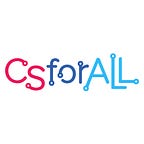Three Big Ideas from the SCRIPT Symposium
When you gather 150 education leaders from 13 states in a room, ideas are bound to flow.
That was certainly the case at the first-ever national CSforALL SCRIPT Symposium, presented by CSforALL in partnership with Dell and UC San Diego.
During the three-day symposium (January 14–16), these education leaders worked collaboratively on plans to bring rigorous, inclusive, and sustainable K-12 computer science (CS) education to all of their students. Partners on-hand to lend their support included representatives from higher education, industry, out-of-school time organizations, curriculum providers, and philanthropy.
Here are three big ideas that emerged from the symposium:
1 — EQUITY
CSforALL is an educational movement to serve all students. The SCRIPT helps districts embrace the values of the national CSforALL movement — rigor, inclusion, and sustainability — and build them into their plans.
District teams at the SCRIPT Symposium began creating K-12 pathways for their students to ensure that CS is treated as a fundamental subject, moving away from CS as an elective course or opportunity for some. A key goal for many districts is to address representation to ensure that all kids see themselves as able to learn CS, regardless of gender, ethnicity, dis/ability, or academic background.
District teams discussed equity in tangible ways, including what constitutes diversity in their communities and how they will support students who are underrepresented and underserved, with implications for what CS gets taught and how it gets taught.
2 — LEADERSHIP
To date, much of the recent CS education momentum has grown from grassroots efforts by teachers across the country. School and district leaders have typically not been engaged in CS education; 30% of principals say that CSforALL is not on their radar (Technology Counts 2018).
The SCRIPT brings leaders to the table and provides them with a structured opportunity to create a strategic plan with their teams. Districts create their own vision for CS education that includes their intended outcome for students and all of the ramifications for leadership, teachers, curriculum and materials, partners, and community.
Our data demonstrate that district teams that set the most goals for leadership and have strong leadership scores are more likely to set teacher capacity-building goals as well. These are promising signs for strategic growth and long-term sustainability.
3 — COHERENCE
Many facilitators and districts reported that they were pleased to adopt a structured approach to expanding CS in their districts during the SCRIPT event. We frequently heard the word “coherence,” not only in the sense of bringing order to disparate pieces, which is the typical state of CS in many districts, but also of organizing around a common vision, expectations for how and what students learn, as well as staffing, curriculum, partnerships, and more.
The SCRIPT is designed to serve as an onboarding and orientation tool for those who are new to CS, but for those already working on CS, the SCRIPT’s step-by-step guidance can help develop or strengthen strategies to bring CS to all students.
The symposium also featured a group facilitator training. The 26 facilitators will act as local SCRIPT trainers and coaches in their respective states, and ensure participants in the initial workshop remain on track toward implementing their CS education plans.
The SCRIPT is the paved road to a future that includes CSforALL. Now that the SCRIPT Symposium is over, we are excited to see its impact across the country.
